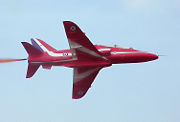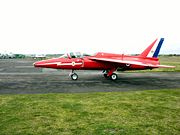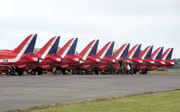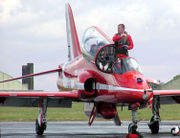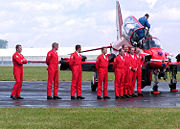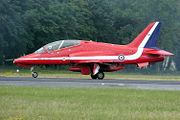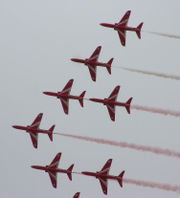Red Arrows
2008/9 Schools Wikipedia Selection. Related subjects: Air & Sea transport
| Royal Air Force Aerobatic Team | |
|---|---|
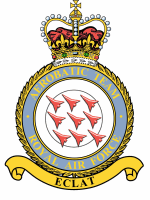 |
|
| Active | 1965- Present |
| Role | Aerobatic Display |
| Garrison/HQ | RAF Scampton |
| Motto | Eclat (Latin: "Excellence") |
| Equipment | 1964 - 1979 Folland Gnat 1980 - present Hawk T1A |
The Red Arrows, officially known as the Royal Air Force Aerobatic Team, is the aerobatics display team of the Royal Air Force, based at RAF Scampton, Lincolnshire, England. They were formed in late 1964 as an all-RAF team, replacing a number of unofficial teams that had been sponsored by various RAF commands.
The Red Arrows badge shows the aircraft in their trademark diamond nine formation, with the motto Eclat, meaning "brilliance" or "excellence".
The Red Arrows were equipped with seven Folland Gnat trainers which were inherited from the RAF Yellowjacks, display team. This aircraft was chosen because it was less expensive to operate than front-line fighters. In their first season, they flew at 65 shows across Europe. In 1966, the team was increased to nine members, enabling them to develop their Diamond Nine formation. In late 1979, they switched to the BAE Hawk trainer. The Red Arrows have now performed nearly 4,000 displays world-wide in over fifty countries.
Team history
Predecessors
The Red Arrows were not the first RAF aerobatics team. An RAF biplane pageant was held at Hendon in 1920 with biplane teams made up of Gauntlets and Gladiators from front-line squadrons. In 1938, three Gladiators flew with their wing-tips tied together. The Second World War largely stopped formation aerobatics, as planes were needed elsewhere.
In 1947, the first jet team of three Vampires came from Odiham Fighter Wing. Various teams flew the Vampire, and in 1950, No. 72 Squadron was flying a team of seven. No. 54 Squadron RAF became the first RAF jet formation team to use smoke trails. Vampires were replaced by Meteors, No 66 Squadron developing a formation team of six aircraft.
Hunter aircraft were first used for aerobatics teams in 1955, when No 54 Squadron flew a formation of four.
The official RAF team was provided by No. 111 Squadron RAF ('Treblers' or 'Treble-One') in 1956, and for the first time the aircraft had a special colour scheme, which was an all-black finish. After a demonstration in France, they were hailed as 'Les Fleches Noires' and from then on known as The Black Arrows. This team became the first team to fly a five-Hunter formation. The Black Arrows' greatest moment was the loop and barrel roll of 22 Hunters during the 1958 Farnborough Air Show. This was a world record for the greatest number of aircraft looped in formation, and remains unbroken to this day. The Black Arrows were the premier team until 1961, when The Blue Diamonds ( No. 92 Squadron RAF) continued their role, flying sixteen blue Hunters.
In 1960, The Tigers ( No. 74 Squadron RAF) were re-equipped with Lightnings and performed wing-overs and rolls with nine aircraft in tight formation. They sometimes gave co-ordinated displays with the Blue Diamonds.
Yet another aerobatics team was formed by No. 56 Squadron RAF, The Firebirds, with nine red and silver Lightnings. In 1964, The Red Pelicans, flying six Jet Provost T Mk 4s, assumed the role of the RAF's leading display team. In that same year, a team of five yellow Gnat trainers from No 4 Flying Training School displayed at the Farnborough Air show. This team became known as the Yellowjacks after Flight Lieutenant Lee Jones's call sign, "Yellowjack"; the name was briefly 'Daffodil Patrol', but was quickly changed back.
In 1964, it was decided to amalgamate all the RAF display teams, as it was feared pilots were spending too much time practising formation aerobatics rather than operational training. The new team name took the word red from the fact that the Yellowjacks' planes had been painted red (as it was a far clearer and visible colour in the sky for safety reasons) and arrows after the Black Arrows; however some think red was a tribute to the Red Pelicans.
The Red Arrows
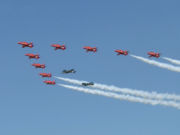
The Red Arrows in formation with two Supermarine Spitfire PRXIX's at RIAT 2005
|
The Royal Air Force Aerobatic Team, the Red Arrows, was based at RAF Kemble, then a satellite unit of the Central Flying School, itself based at RAF Little Rissington, which was considered the "official" home base of the Arrows. Arrows' aircraft would frequently fly into Rissington for maintenance. When RAF Scampton became the CFS Headquarters in 1983, the Red Arrows moved there. As an economy measure, Scampton closed in 1995, so the Red Arrows moved just twenty miles to RAF Cranwell; however, as they still used the air space above Scampton, the emergency facilities and runways had to be maintained. Since December 21, 2000, the Red Arrows have been based again at RAF Scampton, near Lincoln.
The first team, led by Squadron Leader Lee Jones, had seven display pilots and flew the Folland Gnat T1 jet trainer. The first display in the UK was on 6 May 1965 at Little Rissington for a press day. At the subsequent National Air Day display, three days later, at Clermont Ferrand in France, one French journalist described the team as "Les Fleches Rouge", confirming the name "The Red Arrows". By the end of their first season, the Red Arrows had displayed 65 times in Britain, France, Italy, Holland, Germany and Belgium and were awarded the Britannia Trophy by the Royal Aero Club for their contribution to aviation.
In 1968, the then Team Leader (Sqn. Ldr. Ray Hanna AFC) expanded the team from seven to nine jets, as he wanted to expand the team's capabilities and the permutations of formation patterns. It was during this season that the 'Diamond Nine' pattern was formed and it has remained the team's trademark pattern ever since. Ray Hanna stayed as Red Leader for four consecutive years until 1969, a record as Leader which still stands to this day. For his considerable achievements of airmanship with the team, Ray Hanna was awarded a bar to his existing Air Force Cross (AFC).
After displaying 1,292 times in the Folland Gnat, the Red Arrows took delivery of the Hawk trainer in the winter of 1979. Since being introduced into service with the Red Arrows, the Hawk has performed with the Red Arrows in fifty countries.
On the 9 September 2003, a Red Arrow jet veered off the runway at Jersey airport. The pilot, Flight Lieutenant Jez Griggs, ran the jet into a gravel pile and little damage was caused. No one was injured. Displays were not affected because the Red Arrows take a spare aircraft with them.
In July 2004 there was speculation in the British media that the Red Arrows would be disbanded, after a defence spending review, due to running costs of between £5 million and £6 million. The Arrows were not disbanded and the expense has been justified through the public relations value of the arrows, because the Red Arrows help develop business in the defence industry and also because they act as a recruitment mechanism for the RAF. According to the BBC, it is highly unlikely that the Red Arrows will be disbanded, as they are a considerable attraction throughout the world. This was reiterated by then Prime Minister, Tony Blair, in 2007.
With the planned disposal of RAF Scampton the future home of the Red Arrows is uncertain. A move to either RAF Waddington, in Lincolnshire, or RAF Leeming, in North Yorkshire, before the end of the decade is possible.
Pilots
Since 1966, there have been nine display pilots each year, all volunteers. Pilots must have completed one or more operational tours on a fast jet such as the Tornado, Harrier or Jaguar, have accumulated at least 1,500 flying hours and have been assessed as above average in their operational role to be eligible. Even then, there are more than ten applicants for each place on the team. Pilots stay with the Red Arrows for a three-year tour of duty. Three pilots are changed every year, such that there are always three first year pilots, three second year pilots, and three in their final year.
The Red Arrows have no reserve pilots, as a spare pilot would not perform often enough to fly to the standard required. If one of the pilots is not able to fly, the team flies an eight-plane formation. However, if the Team Leader, 'Red 1', is unable to fly then the team does not display at all. Each pilot always flies the same position in a formation. The pilots spend six months from October to April practising for the coming display season.
During an aerobatics display, Red Arrows pilots experience forces up to five times that of gravity, and when performing the aerobatic manoeuvre 'Vixen Break', forces up to 7g can be reached, close to the 8g structural limit of the aircraft.
As well as the nine pilots, 'Red 10', also known as the Road Manager, is a fully qualified Hawk pilot who flies the tenth aircraft when the Red Arrows are away from base. This means the team have a reserve aircraft at the display site. Red 10's duties include co-ordination of the display and acting as the team's Ground Safety Officer. Red 10 also flies TV cameramen and photographers for air-to-air pictures of the Red Arrows.
The engineering team that supports the Red Arrows are known as "The Blues" and consists of 85 members.
Aircraft
The Red Arrows do not use front-line aircraft because of operating costs. While the Hawk is very basic compared to the much more modern Eurofighter Typhoon, it is still fast enough and very manoeuvrable, ideal for low-altitude aerobatics. The Red Arrows normally cruise at 360 knots (about one mile every 10 seconds).
Statistics
- Wing span — 9.39 m
- Length — 11.85 m
- Height — 4.0 m
- Maximum speed sea level — 645 mph (1,037 km/h)
- Maximum altitude — 48,000 ft (15,900 m)
- Empty weight — 8,000 lb (3,630 kg)
- Maximum weight — 18,390 lb (8,330 kg)
- Powerplant — one Rolls-Royce Adour Mk 151
- Thrust — 5,200 lbf (23 kN)
Displays
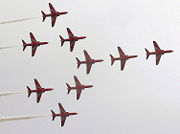
Red Arrows Hawks in Concorde formation
|
The first display by the Red Arrows was at RAF Little Rissington on 6 May 1965. The display was to introduce the Royal Air Force Aerobatic Team to the media. However, the first public display was on 9 May 1965 in France, at the French National Air Day in Clermont-Ferrand. The first public display in the UK was on 15 May 1965 at the International Air Fair at Biggin Hill. The first display with nine aircraft was on 8 July 1966 at RAF Little Rissington.
The first display in Germany was at RAF Laarbruch on 6 August 1965, and since then the Red Arrows have performed in Germany 170 times. However, the Red Arrows' last display in Germany was on 22 August 1988 after formation aerobatics were banned in Germany following the Italian Air Force Frecce Tricolori accident on 28 August 1988 in Ramstein.
During displays, the aircraft do not fly directly over the crowd; any manoeuvres in front of and parallel to the audience can be as low as 300 feet, the 'synchro pair' can go as low as 100 feet straight and level, or 150 feet when in inverted flight. To carry out a full display, the cloud base must be above 4,500 feet; if it is below 2,500 feet then they will perform a 'flat' display, which consists of fly-pasts and steep turns.
One of the biggest crowds to see the Red Arrows was in Lisbon on 13 June 1973, when there was a crowd of 650,000 people, a statistic exceeded in 1996 in Sydney.
The greatest number of displays flown in any year was in 1995, when the Red Arrows performed 136 times. The smallest number of displays in one year was in 1975, after the 1973 oil crisis limited their appearances.
In 1977, a charge of £200 was introduced by the MOD for a Red Arrows display. By 2000, the charge had risen to £2,000 (including VAT and insurance). To date, the Red Arrows have performed over 4,000 displays (the 4,000th being performed at RAF Leuchars in Scotland in September 2006).
UK residents may occasionally see the Red Arrows on a "transit flight" (getting to the display location). On these transit flights, the team flies at the relatively low altitude of 1,000 feet. This avoids the complication of moving though the cloud base in formation, and also avoids much controlled air space. Jets are more efficient at higher altitude, so longer flights are made at 35,000 to 42,000 feet.
The smoke trails left by the team are made by releasing diesel into the exhaust; this oxidises straight away, leaving a white smoke trail. Dyes can be added to produce the different colours. The diesel is stored in the pod on the underside of the plane; designed to carry a 30mm ADEN cannon, it now houses three tanks: one 50-gallon tank of pure diesel and two 10-gallon tanks of blue- and red-dyed diesel. The smoke system uses ten gallons per minute; therefore each plane can trail smoke for a total of seven minutes; (5 minutes of white smoke, 1 minute of blue and 1 minute of red is carried).
Accidents and incidents
- 1969 - Two Red Arrows Gnats crashed.
- 1971 - Two Gnats collided during the cross-over manoeuvre.
- 1980 - A Hawk jet from the Red Arrows hit a yacht mast at an air show in Sussex, the pilot ejected safely.
- 1986 - A Red Arrows Hawk rammed into the back of another on a runway.
- 1988/89 - A Red Arrow Hawk crashed into a house in the neighbouring village of Welton while practicing.
- 2007 - The wingtip of one Red Arrows Hawk hit the tail of another during practice flight near RAF Scampton.
Video game
In 1985, Database Software released a flight simulator called Red Arrows, made in cooperation with the flight team. In the simulator, stunts have to be performed while flying in formation. It was available for ZX Spectrum, Commodore 64, Amstrad, Electron, BBC Micro and Atari.
